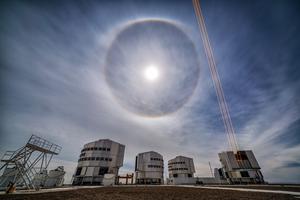Glossary term: Observatoire
Description: Un observatoire est un site ou un bâtiment dédié aux observations astronomiques. Les observations optiques et infrarouges sont généralement effectuées à l'aide de télescopes placés dans des dômes. Les observatoires astronomiques modernes, optiques, infrarouges ou submillimétriques, basés au sol, sont érigés au sommet des montagnes, au-dessus de la plus grande partie possible de l'atmosphère terrestre. Ces observatoires disposent d'instruments spécialisés tels que des télescopes, des caméras et des spectrographes. Un emplacement élevé est moins nécessaire pour les observatoires de radioastronomie et de rayons cosmiques. D'autres parties du spectre électromagnétique (rayons gamma, rayons X, rayons ultraviolets et rayons infrarouges de plus grande longueur d'onde) peuvent être étudiées à l'aide de télescopes spatiaux spécifiques, parfois également appelés observatoires.
Related Terms:
- Rayon cosmique (ou Rayonnement cosmique)
- Rayonnement électromagnétique
- Rayon gamma
- Infrarouge (IR)
- Rayonnement micro-ondes
- Ondes radio
- Télescope
- Ultraviolet
- Spectre visible
- Astronomie des rayons cosmiques
- Astronomie submillimétrique
See this term in other languages
Term and definition status: The original definition of this term in English have been approved by a research astronomer and a teacher The translation of this term and its definition is still awaiting approval
The OAE Multilingual Glossary is a project of the IAU Office of Astronomy for Education (OAE) in collaboration with the IAU Office of Astronomy Outreach (OAO). The terms and definitions were chosen, written and reviewed by a collective effort from the OAE, the OAE Centers and Nodes, the OAE National Astronomy Education Coordinators (NAECs) and other volunteers. You can find a full list of credits here. All glossary terms and their definitions are released under a Creative Commons CC BY-4.0 license and should be credited to "IAU OAE".
If you notice a factual or translation error in this glossary term or definition then please get in touch.
Related Media
Chilean observatories at home office, by Robert Barsa, Slovakia
Credit: Robert Barsa/IAU OAE
License: CC-BY-4.0 Creative Commons Attribution 4.0 International (CC BY 4.0) icons
ESO's Very Large Telescope (VLT) at Paranal Observatory with a lunar halo
Credit: Juan Carlos Muñoz-Mateos/ESO credit link
License: CC-BY-4.0 Creative Commons Attribution 4.0 International (CC BY 4.0) icons
Télescopes Keck
Credit: NASA/JPL credit link
License: PD Public Domain icons
Télescope spatial Hubble en orbite terrestre
Credit: NASA/ESA credit link
License: CC-BY-4.0 Creative Commons Attribution 4.0 International (CC BY 4.0) icons
Parkes Radio Telescope
Credit: David McClenaghan/CSIRO credit link
License: CC-BY-3.0 Creative Commons Attribution 3.0 non transposé icons













